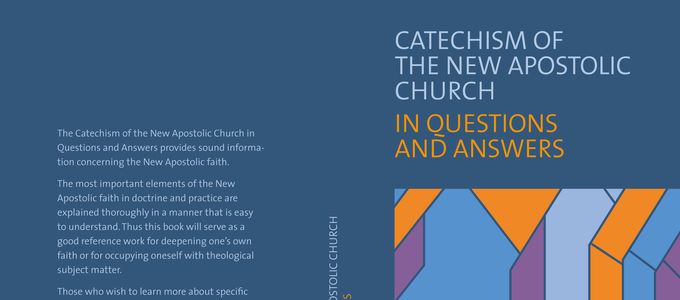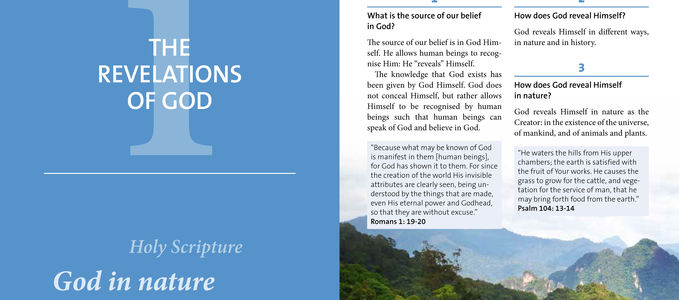
The “new” version of the Catechism in questions and answers is just about to be launched. The content is the same as the long version, although divided up into questions and answers. Time to take stock and see how the Catechism has been received and understood.
The Catechism of the New Apostolic Church was launched in January 2013, following a ten-year development phase. How has this book about the New Apostolic faith been received and understood? Has the Catechism fulfilled its purpose of clearly explaining the doctrine?
A book tracing the profile of the New Apostolic Church and its specifics
The working group “Contacts with Denominations and Religions” paints a positive picture. “The Catechism has been received positively by the Churches. It is read, and it serves as a basis for discussions on the theological differences between the Churches. It is also understood as a book that profiles those things that are typically New Apostolic. They are discerned and discussed.” This is what Apostle Volker Kühnle, chairman of the working group, says about his experiences so far. In his opinion it is particularly the New Apostolic understanding of the Apostle ministry and the imminent return of Jesus Christ that are the focus of criticism by other Churches, as are the sacramental acts of the Apostles on souls in the beyond.
Clearly, there are similarities and differences. A Catechism must meet two requirements. It must be able to describe the similarities—such as the confessions of the early church—and highlight the Church’s own profile, such as the New Apostolic conception of the departed.
More importance on theology and Bible reading
What do other Churches say about the Catechism of the New Apostolic Church? Following are some echoes:
“The opening of the New Apostolic Church in recent years where ecumenism is concerned has not gone unnoticed and has had an impact,” Kai Funkschmidt of the Evangelical Central Office for Questions about World Views in Germany says. “There have been many ecumenical discussions, and theology and Bible reading has been given a higher priority. That which ecumenism wants to achieve has been taken up by the Catechism,” he says in a leaflet titled Kompaktinfo Neuapostolische Kirche (Compact information on the New Apostolic Church) in which the New Apostolic Church and its definition of church is discussed.
“The large differences between the various teachings limit ecumenical reconciliation, but they do not preclude or prevent ecumenical memberships or cooperations on other levels. The differences in doctrine between the New Apostolic Church and other Churches are not greater or more substantial than between other Churches that are already involved in the ecumenical movement,” Kai Funkschmidt says.
Working together in a secularised public sphere
“As I see it, the new Catechism is an important building block for the current talks going on in many parishes and free churches on the possibilities of testimony and common activities in a secularised public sphere,” Professor Friedrich Weber says, the former national bishop of the Evangelical-Lutheran State Church of Brunswick (Germany) and President of the Association of Evangelical Churches in Europe. This fundamental work “provides important starting points for an ecumenical cooperation with the New Apostolic Church” and shows the willingness of the New Apostolic Church “that it wants to meet with the other Christian churches specifically for an ecumenical collaboration with them”.
“The corresponding changes in the New Apostolic Church’s self-image and in its doctrine can now also be found in the Catechism, as well as those points requiring further discussion,” Weber writes in the Materialdienst, a magazine of the Interconfessional Institute of Bensheim. Professor Weber, who has in the meantime died, was chairman of the Working Group of Christian Churches (ACK) in Germany from 2007 to 2013.
A standard for New Apostolic faith life
Such comments show that the Catechism has fulfilled its function of explaining the New Apostolic faith, of writing it down, and exposing it to the public. Its purpose, however, goes further. In the foreword of the book it says, “The New Apostolic Church is active in many countries of varying cultural backgrounds, which makes a uniform foundational work such as this necessary in order to reinforce doctrinal unity despite all other differences.” And “The Catechism has been written in faith for people of faith. It is a standard for New Apostolic faith life.”
In September, the Catechism will be launched as a question-and-answer book. The text of the long version of the Catechism has been divided into 750 questions and answers. To allow readers to have easy access to some of the more complex content, the themes were grouped into a large number of isolated questions and responses. This way the sections could be kept short. The text is formulated in the clearest way possible, without using too many technical terms. For certain concepts, explanations have been given or even expanded on compared to the long version of the Catechism.
The long version of the Catechism of the New Apostolic Church is available as a bound book, an app, or on the Internet.










